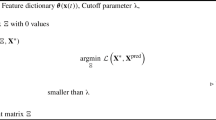Abstract
In this paper, the problem of optimal robust fault detection (FD) for uncertain Lipschitz nonlinear systems is considered. A robust active fault detection approach for a class of the Lipschitz nonlinear systems in the presence of disturbances and parametric uncertainties is proposed, wherein the Lipschitz constant is assumed as one of the optimization parameters in the observer design. In addition to disturbance attenuation level, the fault sensitivity criterion based on \(H_-\) index is also defined in the FD system design. Different criteria are defined as a weighted multi-objective linear matrix inequality optimization problem, and the optimal variables of the FD system are derived based on a newly defined cost function. A numerical example is provided to demonstrate the effectiveness of the proposed FD system. The results show the robustness of the proposed method against parametric uncertainty and nonlinear uncertainty as well.








Similar content being viewed by others
References
M. Abbaszadeh, H.J. Marquez, Nonlinear robust \(H_\infty \) filtering for a class of uncertain systems via convex optimization. J. Control Theory Appl. 10(2), 152–158 (2012)
M. Abbaszadeh, H.J. Marquez, Robust \(H_\infty \) observer design for a class of nonlinear uncertain systems via convex optimization, in Proceedings of American Control Conference, pp. 1699–1704 (2007)
S. Ahmadizadeh, J. Zarei, H.R. Karimi, Robust unknown input observer design for linear uncertain time delay systems with application to fault detection. Asian J. Control. 16(4), 1006–1019 (2014)
S. Asgari, A. Yazdizadeh, M.G. Kazemi, Robust model-based fault detection and isolation for V47/660kW wind turbine. AUT J. Model. Simul. 45(1), 55–66 (2015)
J. Chen, R.J. Patton, Robust Model-based Fault Diagnosis for Dynamic Systems (Kluwer Academic Publishers, Dordrecht, 1999)
M.Z. Chen, Q. Zhao, D.H. Zhou, A robust fault detection approach for nonlinear systems. Int. J. Automa. Comput. 3(1), 23–28 (2006)
W. Chen, A. Khan, M. Abid, S. Ding, Integrated design of observer based fault detection for a class of uncertain nonlinear systems. Int. J. Appl. Math. Comput. Sci. 21(3), 423–430 (2011)
M.R. Davoodi, A. Golabi, H.A. Talebi, H.R. Momeni, Simultaneous fault detection and control design for switched linear systems: a linear matrix inequality approach. J. Dyn. Syst. Meas. Control. 134(6), 061010 (2012)
S. Dhahri, A. Sellami, F.B. Hmida, Robust \(H_\infty \) sliding mode observer design for fault estimation in a class of uncertain nonlinear systems with LMI optimization approach. Int. J. Control Autom. Syst. 10(5), 1032–41 (2012)
S.X. Ding, Model-Based Fault Diagnosis Techniques (Springer, Berlin, 2008)
L. Fortuna, P. Arena, D. Balya, A. Zarandy, Cellular neural networks: a paradigm for nonlinear spatio-temporal processing. IEEE Circuits Syst. Mag. 1(4), 6–21 (2001)
Z. Gao, C. Cecati, S.X. Ding, A survey of fault diagnosis and fault-tolerant techniques Part I: Fault diagnosis with model-based and signal-based approaches. IEEE Trans. Ind. Electron. 62(6), 3757–3767 (2015)
Z. Gao, S.X. Ding, Fault reconstruction for Lipschitz nonlinear descriptor systems via linear matrix inequality approach. Circuits Syst. Signal Process. 27(3), 295–308 (2008)
Z. Gao, X. Liu, M.Z. Chen, Unknown input observer-based robust fault estimation for systems corrupted by partially decoupled disturbances. IEEE Trans. Ind. Electron. 63(4), 2537–2547 (2016)
L. Hongyi, Robust control design for vehicle active suspension systems with uncertainty. Ph.D. dissertation, University of Portsmouth (2012)
S. Huang, Z. Xiang, H.R. Karimi, Mixed \(L/L_1\) fault detection filter design for fuzzy positive linear systems with time-varying delays. IET Control Theory Appl. 8(12), 1023–1031 (2014)
I. Hwang, S. Kim, C.E. Seah, A Survey of fault detection, isolation, and reconfiguration methods. IEEE Trans. Control Syst. Technol. 18(3), 636–653 (2010)
A.Q. Khan, M.R. Abid, W. Chen, S.X. Ding, On optimal fault detection of nonlinear systems, in Decision and Control, CDC/CCC, pp. 1032–1037 (2009)
L. Li, S.X. Ding, Y. Yang, Y. Zhang, Robust fuzzy observer-based fault detection for nonlinear systems with disturbances. Neurocomputing 174, 767–772 (2016)
L. Li, S.X. Ding, J. Qiu, Y. Yang, D. Xu, Fuzzy observer-based fault detection design approach for nonlinear processes. IEEE Trans. Syst. Man Cybern. Syst. 47(8), 1941–1952 (2017)
S. Li, Z. Xiang, H.R. Karimi, Mixed \(l/l_1\) fault detection observer design for positive switched systems with time-varying delay via delta operator approach. Int. J. Control Autom. Syst. 12(4), 709–721 (2014)
A. Marcos, S. Ganguli, G.J. Balas, An application of \(H\infty \) fault detection and isolation to a transport aircraft. Control Eng. Pract. 13(1), 105–119 (2005)
S.K. Nguang, P. Zhang, S.X. Ding, Parity relation based fault estimation for nonlinear systems: an LMI approach. Int. J. Autom. Comput. 4(2), 164–168 (2007)
H.M. Qian, Z.D. Fu, J.B. Li, L.L. Yu, Robust fault diagnosis algorithm for a class of lipschitz system with unknown exogenous disturbances. Measurement 46(8), 2324–2334 (2013)
S. Raghavan, J. Hedrick, Observer design for a class of nonlinear systems. Int. J. Control. 59(2), 515–528 (1994)
R. Rajamani, Observers for Lipschitz nonlinear systems. IEEE Trans. Autom. Control. 43(3), 397–401 (1998)
Y.D. Sergeyev, D.E. Kvasov, Global search based on efficient diagonal partitions and a set of Lipschitz constants. SIAM J. Optim. 16(3), 910–937 (2006)
C. Sun, F. Wang, X. He, Robust fault estimation for Takagi–Sugeno nonlinear systems with time-varying state delay. Circuits Syst. Signal Process. 34(2), 641 (2015)
P.S. Teh, H. Trinh, Design of unknown input functional observers for nonlinear systems with application to fault diagnosis. J. Process Control. 23(8), 1169–1184 (2013)
F. Thau, Observing the state of nonlinear dynamic systems. Int. J. Control. 17(3), 471–479 (1973)
D. Wang, M. Yu, C.B. Low, S. Arogeti, Model-Based Health Monitoring of Hybrid Systems (Springer, Berlin, 2013)
Y. Wang, L. Xie, C.E. de Souza, Robust control of a class of uncertain nonlinear systems. Syst. Control Lett. 19(2), 139–149 (1992)
M. Witczak, J. Korbicz, R. Jzefowicz, Design of unknown input observers for non-linear stochastic systems and their application to robust fault diagnosis. Control Cybern. 42(1), 227–256 (2013)
M. Xiang, Z. Xiang, Robust fault detection for switched positive linear systems with time-varying delays. ISA Trans. 53(1), 10–16 (2014)
Y. Yang, S.X. Ding, L. Li, On observer-based fault detection for nonlinear systems. Syst. Control Lett. 82, 18–25 (2015)
J. Zarei, E. Shokri, Robust sensor fault detection based on nonlinear unknown input observer. Measurement 48, 355–367 (2014)
C.F. Zhang, M. Yan, J. He, C. Luo, LMI-based sliding mode observers for incipient faults detection in nonlinear system. J. Appl. Math. 2012 (2012). https://doi.org/10.1155/2012/528932
Y. Zhang, J. Jiang, Bibliographical review on reconfigurable fault-tolerant control systems. Annu. Rev. Control. 32(2), 229–252 (2008)
M. Zhou, Z. Wang, Y. Shen, M. Shen, \(H_-/H_\infty \) fault detection observer design in finite-frequency domain for Lipschitz non-linear systems. IET Control Theory Appl. 11(14), 2361–2369 (2017)
Author information
Authors and Affiliations
Corresponding author
Appendix
Appendix
In this section, the proposed method is applied to an active suspension system as a real-world system. The configuration of the system is depicted in Fig. 9.
A quarter car model [15]
State space representation of the system is given by
The states of the system are defined as suspension deflection, tire deflection, sprung mass speed and unsprung mass speed, respectively, which are represented as the following equations.
Disturbance is considered as
which is simulated as follows.
The nonlinear term of the state space equation is defined as the subsequent equation.
According to [15], the parameters of the system, their definition and considered values of the active suspension system are tabulated in Table 3.
By using the values in the table, the matrices of the system can be obtained as:
The disturbance and fault distribution matrices are defined as:
Two actuator and sensor faults are considered for the system. The disturbance distribution matrices are assumed as \(D_1\) and \(D_2\) that is different from (61), which is considered for more strict conditions wherein disturbance can influence all states of the system instead of \(x_2\) and \(x_4\). It is also worth noting that the selection of disturbance and fault distribution matrices has a direct effect on the disturbance attenuation level, fault sensitivity and achievable Lipschitz constant as well.
The parametric uncertainties in the matrices of the system in (61) are assumed as follows.
The parameters for the observer design are considered as:
The obtained results of the theorem for different weighting factors of the optimization problem are given in Figs. 10 and 11.
The optimal value for the weighing factor is obtained as \(W=0.9\). One can obtain the following optimal values by solving the LMI problem.
The observer gain is achieved as:
The given values are obtained for \(k_1=k_2=k_3=1\). The optimal values of these coefficients and validation of the proposed method for an experimental setup are considered as future works of this study.
Rights and permissions
About this article
Cite this article
Kazemi, M.G., Montazeri, M. Robust Fault Detection of Uncertain Lipschitz Nonlinear Systems with Simultaneous Disturbance Attenuation Level and Enhanced Fault Sensitivity and Lipschitz Constant. Circuits Syst Signal Process 37, 4256–4278 (2018). https://doi.org/10.1007/s00034-018-0771-2
Received:
Revised:
Accepted:
Published:
Issue Date:
DOI: https://doi.org/10.1007/s00034-018-0771-2







